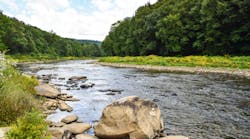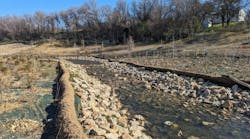Keyser, W.V., a small town with an estimated population of just 5,515, had nothing in the way of retail besides a Walmart. So when a local entrepreneur decided to build a new $7 million outdoor shopping complex on the outskirts of town, it was a big deal for local residents.
“This was much needed and very exciting,” said Kevin Sandridge of Norco, who served as project manager. “There was nothing here before but a field with mountains on either side.”
Seven acres of the 15-acre site were partially developed to include two large buildings, both 91 ft wide, one 260 ft long and the other 380 ft long.
A storm water detention system was specified by the engineers at Rummel, Klepper & Kahl (RK&K), who were looking for the most cost-effective underground storage system available. The system needed to be placed under the parking lot, where it could hold water that would be let out slowly into the creek across the road without flooding it.
Because there was not enough difference in elevation to provide natural runoff, the system needed to hold a large amount of water. About the size of a football field, the site demanded close to 100,000 cu ft of storage.
The Triton Stormwater Solutions Retention System was selected. “We called three or four different companies,” said Walter Hull, project engineer for RK&K. “It was really price-driven in the end.”
The larger the project, the greater the cost savings when using the system, according to Joe Miskovich, president of Triton Stormwater Solutions. “What we’re seeing on mid-range jobs is a total install savings of between 20% and 30%,” he said. “On larger jobs, we’re seeing even greater cost savings.”
Triton’s proprietary design and patented construction offers large-capacity, lightweight, easy-to-install storm water chambers that are more than 50% stronger than traditional products. The storm water chambers have 46% greater capacity per linear foot and can withstand 16,000 more pounds of pressure than traditional chambers, according to independent tests. A key feature is that each chamber weighs only 32 lb, enabling workers to carry two or three at a time.
In addition, the system is designed for service and maintenance with the use of bottom pieces and sumps in addition to chambers and end pieces for easy access. Made of soy resin, Triton products provide up to 21 LEED credits.
First, the crew excavated down to elevation and put down a 6-in. base layer of stone. Next, the chambers were put in and the walls of the trench were lined with a Class 2 non-woven geofabric. The site was backfilled with stones up to 6 in. past the crown of the chambers and the geofabric was folded back down and backfilled with material to the desired elevation, with the chambers needing to be placed under only 16 in. of cover.
Justin Doss, owner of FC & Sons Excavating, which installed the system, had never worked with these chambers before. “I like that they are lightweight and stackable,” he said. “I have worked with similar systems on the market, but Triton is lighter and easier to handle than the others. I would be happy to work with Triton again.”
Download: Here






